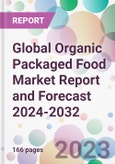According to the report, the global organic packaged food market is projected to grow at a CAGR of 7.4% between 2024 and 2032 reaching a value of approximate USD 354.05 billion by 2032. Aided by the surging consumer interest in healthy, chemical-free eating, and the broadening distribution channels for organic products, the market is expected to grow significantly by 2032.
Organic packaged foods refer to certified food products that are produced using methods that do not involve modern synthetic inputs such as synthetic pesticides and chemical fertilisers. These products are seen as more environmentally friendly due to their sustainable methods of production. Moreover, they are perceived as healthier options due to the absence of harmful chemicals and genetically modified organisms (GMOs). These products range from organic fruits and vegetables, dairy products, meats, grains, and ready-to-eat meals that are packaged and branded.
The driving force behind the global organic packaged food market growth is the heightened consumer consciousness regarding health and wellness. The 21st century has seen a pivotal shift in consumer behaviour towards foods that are not only nutritious but also sustainable and ethical. This has led to a substantial rise in the demand for organic products, which are often perceived as cleaner, purer, and more beneficial in comparison to their conventionally grown counterparts.
As per the organic packaged food market analysis, the amplified reports and concerns over the adverse effects of chemicals, pesticides, and artificial additives present in food products have prompted many consumers to gravitate towards organic options. The increasing cases of health problems associated with synthetic additives have only added to the urgency of this shift.
Another pivotal factor spurring the organic packaged food market is the expansion of distribution channels. Initially, organic products were majorly limited to speciality stores and farmer's markets. However, with the burgeoning demand, supermarkets, hypermarkets, and even online retailers have expanded their organic product offerings, making them easily accessible to a broader consumer base and further propelling the organic packaged food market demand.
Furthermore, the continuous innovations in organic packaged foods, including diverse cuisines, flavours, and convenient packaging, have played a crucial role in attracting a larger consumer segment. Brands are capitalising on the 'organic' label, introducing a plethora of products ranging from organic snacks, desserts, ready-to-eat meals, and beverages, further increasing the value of the organic packaged food market size.
Organic packaged foods refer to certified food products that are produced using methods that do not involve modern synthetic inputs such as synthetic pesticides and chemical fertilisers. These products are seen as more environmentally friendly due to their sustainable methods of production. Moreover, they are perceived as healthier options due to the absence of harmful chemicals and genetically modified organisms (GMOs). These products range from organic fruits and vegetables, dairy products, meats, grains, and ready-to-eat meals that are packaged and branded.
The driving force behind the global organic packaged food market growth is the heightened consumer consciousness regarding health and wellness. The 21st century has seen a pivotal shift in consumer behaviour towards foods that are not only nutritious but also sustainable and ethical. This has led to a substantial rise in the demand for organic products, which are often perceived as cleaner, purer, and more beneficial in comparison to their conventionally grown counterparts.
As per the organic packaged food market analysis, the amplified reports and concerns over the adverse effects of chemicals, pesticides, and artificial additives present in food products have prompted many consumers to gravitate towards organic options. The increasing cases of health problems associated with synthetic additives have only added to the urgency of this shift.
Another pivotal factor spurring the organic packaged food market is the expansion of distribution channels. Initially, organic products were majorly limited to speciality stores and farmer's markets. However, with the burgeoning demand, supermarkets, hypermarkets, and even online retailers have expanded their organic product offerings, making them easily accessible to a broader consumer base and further propelling the organic packaged food market demand.
Furthermore, the continuous innovations in organic packaged foods, including diverse cuisines, flavours, and convenient packaging, have played a crucial role in attracting a larger consumer segment. Brands are capitalising on the 'organic' label, introducing a plethora of products ranging from organic snacks, desserts, ready-to-eat meals, and beverages, further increasing the value of the organic packaged food market size.
Market Segmentation
The market can be divided based on product and region.
Market Breakup by Product
- Dairy, Bakery, and Confectioneries
- Meat, Seafood, Fruits, and Vegetables
- Sauces, Dressings, Condiments, and Spreads
- Others
Market Breakup by Region
- North America
- Europe
- Asia Pacific
- Latin America
- Middle East and Africa
Competitive Landscape
The report looks into the market shares, plant turnarounds, capacities, investments, and mergers and acquisitions, among other major developments, of the leading companies operating in the global organic packaged food market. Some of the major players explored in the report are as follows:- Arla Foods amba
- Danone S.A (EPA: BN)
- The Hain Celestial Group, Inc. (NASDAQ: HAIN)
- Nestlé S.A (SWX: NESN)
- Organic Valley
- Others
Table of Contents
1 Preface2 Report Coverage - Key Segmentation and Scope4 Key Assumptions7 Opportunities and Challenges in the Market15 Value Chain Analysis17 Key Trends and Developments in the Market
3 Report Description
5 Executive Summary
6 Snapshot
8 Global Organic Packaged Food Market Analysis
9 North America Organic Packaged Food Market Analysis
10 Europe Organic Packaged Food Market Analysis
11 Asia Pacific Organic Packaged Food Market Analysis
12 Latin America Organic Packaged Food Market Analysis
13 Middle East and Africa Organic Packaged Food Market Analysis
14 Market Dynamics
16 Competitive Landscape
List of Key Figures and Tables
Companies Mentioned
- Arla Foods amba
- The Hain Celestial Group Inc. (NASDAQ: HAIN)
- Danone S.A (EPA: BN)
- Nestlé S.A (SWX: NESN)
- Organic Valley
Methodology

LOADING...








